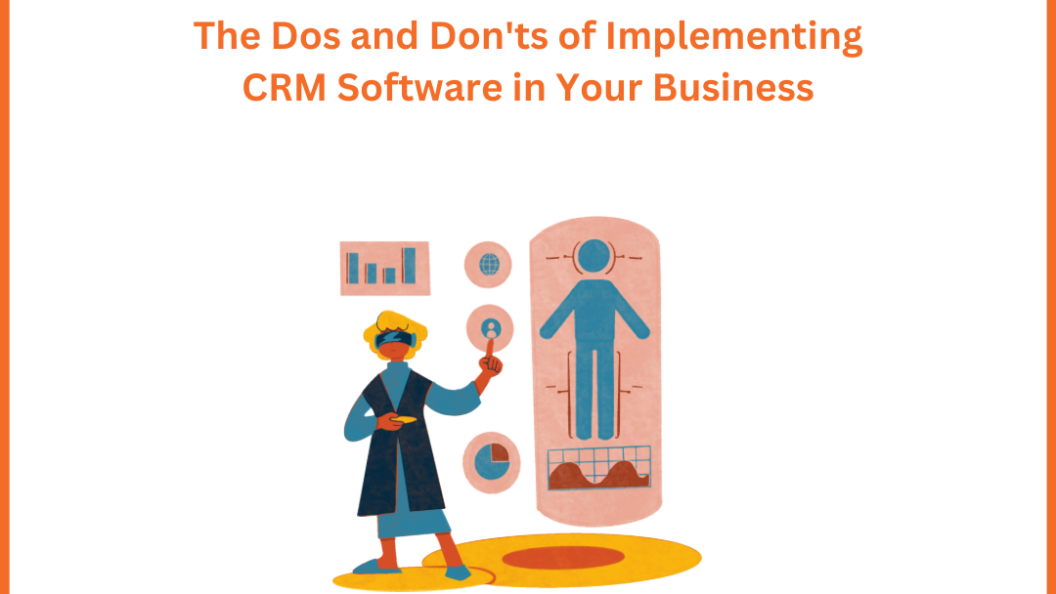Customer Relationship Management (CRM) software has become an essential tool for businesses looking to manage their customer relationships effectively. The software can help businesses streamline their sales and marketing processes, improve customer satisfaction, and drive revenue growth. However, implementing CRM software is not always straightforward, and businesses need to be aware of the dos and don’ts of the process to ensure success. In this article, we will explore the dos and don’ts of implementing CRM software in your business.
The Dos
Define Your Business Needs and Goals
The first step in implementing CRM software is to define your business needs and goals. This will help you select the right software that meets your specific requirements. Take the time to identify the areas of your business that need improvement and create a list of goals you hope to achieve with the CRM software. With a clear understanding of your needs and goals, you will be able to choose the right CRM software that fits your business model.
Involve Key Stakeholders in the Decision-Making Process
The implementation of CRM software affects different departments within your organization. Therefore, it is crucial to involve key stakeholders in the decision-making process. These stakeholders may include department heads, managers, and end-users who will be using the CRM software daily. Involve these stakeholders in the selection and implementation process to ensure that the software meets the needs of the organization and is user-friendly.
Train Your Staff
CRM software can only be effective if your staff knows how to use it. Therefore, it is essential to provide adequate training to your staff to ensure that they are proficient in using the software. A well-trained workforce will improve the efficiency of your business processes and boost productivity. Also, consider appointing a super-user or an internal expert who can help staff members who are struggling with the software.
Integrate CRM Software with Other Business Systems
Integration of your CRM software with other business systems can significantly enhance its functionality. For instance, you can integrate the software with your accounting system to ensure that you have a complete view of customer financial data. Integration of your CRM with other business systems will improve your overall business efficiency and provide a comprehensive view of your customer relationships.
Develop a Data Management Strategy
The success of your CRM software implementation depends on the quality of your data. Therefore, it is essential to develop a data management strategy that includes data storage, backup, and security protocols. Ensure that your data management strategy complies with relevant regulations and that all data is accessible to authorized personnel only.
The Don’ts
Don’t Select a CRM Software Based on Price Alone
When selecting CRM software, price should not be the only factor to consider. While a cheaper software option may seem appealing, it may not meet your business needs and could end up costing you more in the long run. The selection process should be based on a combination of factors, including functionality, user-friendliness, scalability, and the vendor’s reputation.
Don’t Overcomplicate the Implementation Process
Implementing CRM software does not have to be complicated. Many businesses fall into the trap of overcomplicating the process, resulting in unnecessary delays and costs. Keep the implementation process simple and focus on the areas that require the most attention. Work with your CRM vendor to create an implementation plan that suits your business needs and ensures a smooth transition to the new system.
Don’t Ignore End-User Feedback
Your end-users will be the ones using the CRM software daily. Therefore, it is crucial to listen to their feedback during the implementation process. Their feedback can help you identify areas of the software that require improvement and ensure that the software meets their needs. Additionally, involving end-users in the implementation process can improve user adoption and reduce resistance to change.



http://pinupaz.top/# pin-up
same-day Viagra shipping: Viagra without prescription – same-day Viagra shipping
secure checkout ED drugs: cheap Cialis online – cheap Cialis online
secure checkout ED drugs: reliable online pharmacy Cialis – cheap Cialis online
buy generic Cialis online: FDA approved generic Cialis – reliable online pharmacy Cialis
legit Viagra online: no doctor visit required – safe online pharmacy
safe modafinil purchase: modafinil 2025 – buy modafinil online
cheap Cialis online: secure checkout ED drugs – online Cialis pharmacy
http://modafinilmd.store/# modafinil legality
Modafinil for sale: modafinil legality – doctor-reviewed advice
online Cialis pharmacy: reliable online pharmacy Cialis – online Cialis pharmacy
http://maxviagramd.com/# Viagra without prescription
doctor-reviewed advice: modafinil pharmacy – purchase Modafinil without prescription
Amo Health Care: Amo Health Care – purchase amoxicillin 500 mg
Amo Health Care: amoxicillin 500mg capsule buy online – cost of amoxicillin
PredniHealth: prednisone pills for sale – iv prednisone
Amo Health Care: can you buy amoxicillin over the counter in canada – Amo Health Care
Medications online Australia pharmacy online australia PharmAu24
PharmAu24: Discount pharmacy Australia – Pharm Au 24
http://biotpharm.com/# buy antibiotics from india
buy antibiotics from canada BiotPharm get antibiotics without seeing a doctor
buy antibiotics from india: BiotPharm – buy antibiotics online
https://pharmau24.shop/# Online drugstore Australia
buy antibiotics over the counter: BiotPharm – buy antibiotics from india
Buy medicine online Australia Pharm Au 24 online pharmacy australia
http://eropharmfast.com/# erectile dysfunction medication online
ed med online: buying erectile dysfunction pills online – Ero Pharm Fast
buy antibiotics over the counter buy antibiotics online uk buy antibiotics from india
http://pharmau24.com/# online pharmacy australia
Ero Pharm Fast buy ed meds online Ero Pharm Fast
pharmacy online australia: pharmacy online australia – PharmAu24